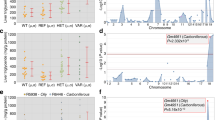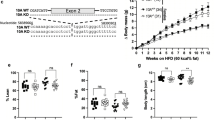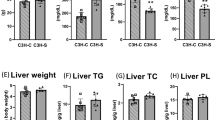Abstract
Hypertriglyceridemia is a hallmark of many disorders, including metabolic syndrome, diabetes, atherosclerosis and obesity1,2,3. A well-known cause is the deficiency of lipoprotein lipase (LPL), a key enzyme in plasma triglyceride hydrolysis4,5,6. Mice carrying the combined lipase deficiency (cld) mutation show severe hypertriglyceridemia owing to a decrease in the activity of LPL and a related enzyme, hepatic lipase (HL)7,8,9, caused by impaired maturation of nascent LPL and hepatic lipase polypeptides in the endoplasmic reticulum (ER)10. Here we identify the gene containing the cld mutation as Tmem112 and rename it Lmf1 (Lipase maturation factor 1). Lmf1 encodes a transmembrane protein with an evolutionarily conserved domain of unknown function that localizes to the ER. A human subject homozygous for a deleterious mutation in LMF1 also shows combined lipase deficiency with concomitant hypertriglyceridemia and associated disorders. Thus, through its profound effect on lipase activity, LMF1 emerges as an important candidate gene in hypertriglyceridemia4,11,12.
This is a preview of subscription content, access via your institution
Access options
Subscribe to this journal
Receive 12 print issues and online access
$209.00 per year
only $17.42 per issue
Buy this article
- Purchase on Springer Link
- Instant access to full article PDF
Prices may be subject to local taxes which are calculated during checkout





Similar content being viewed by others
References
Austin, M.A., Hokanson, J.E. & Edwards, K.L. Hypertriglyceridemia as a cardiovascular risk factor. Am. J. Cardiol. 81, 7B–12B (1998).
Ginsberg, H.N. & Stalenhoef, A.F. The metabolic syndrome: targeting dyslipidaemia to reduce coronary risk. J. Cardiovasc. Risk 10, 121–128 (2003).
Pejic, R.N. & Lee, D.T. Hypertriglyceridemia. J. Am. Board Fam. Med. 19, 310–316 (2006).
Henderson, H.E. et al. Lipoprotein lipase activity is decreased in a large cohort of patients with coronary artery disease and is associated with changes in lipids and lipoproteins. J. Lipid Res. 40, 735–743 (1999).
Mead, J.R., Irvine, S.A. & Ramji, D.P. Lipoprotein lipase: structure, function, regulation, and role in disease. J. Mol. Med. 80, 753–769 (2002).
Merkel, M., Eckel, R.H. & Goldberg, I.J. Lipoprotein lipase: genetics, lipid uptake, and regulation. J. Lipid Res. 43, 1997–2006 (2002).
Paterniti, J.R. Jr, Brown, W.V., Ginsberg, H.N. & Artzt, K. Combined lipase deficiency (cld): a lethal mutation on chromosome 17 of the mouse. Science 221, 167–169 (1983).
Peterfy, M., Mao, H.Z. & Doolittle, M.H. The cld mutation: narrowing the critical chromosomal region and selecting candidate genes. Mamm. Genome 17, 1013–1024 (2006).
Reue, K. & Doolittle, M.H. Naturally occurring mutations in mice affecting lipid transport and metabolism. J. Lipid Res. 37, 1387–1405 (1996).
Briquet-Laugier, V., Ben-Zeev, O., White, A. & Doolittle, M.H. cld and lec23 are disparate mutations that affect maturation of lipoprotein lipase in the endoplasmic reticulum. J. Lipid Res. 40, 2044–2058 (1999).
Elbein, S.C. et al. Molecular screening of the lipoprotein lipase gene in hypertriglyceridemic members of familial noninsulin-dependent diabetes mellitus families. J. Clin. Endocrinol. Metab. 79, 1450–1456 (1994).
Helio, T., Palotie, A., Sane, T., Tikkanen, M.J. & Kontula, K. No evidence for linkage between familial hypertriglyceridemia and apolipoprotein B, apolipoprotein C–III or lipoprotein lipase genes. Hum. Genet. 94, 271–278 (1994).
Blanchette-Mackie, E.J. et al. Effect of the combined lipase deficiency mutation (cld/cld) on ultrastructure of tissues in mice. Diaphragm, heart, brown adipose tissue, lung, and liver. Lab. Invest. 55, 347–362 (1986).
Davis, R.C., Ben-Zeev, O., Martin, D. & Doolittle, M.H. Combined lipase deficiency in the mouse. Evidence of impaired lipase processing and secretion. J. Biol. Chem. 265, 17960–17966 (1990).
Scow, R.O., Schultz, C.J., Park, J.W. & Blanchette-Mackie, E.J. Combined lipase deficiency (cld/cld) in mice affects differently post-translational processing of lipoprotein lipase, hepatic lipase and pancreatic lipase. Chem. Phys. Lipids 93, 149–155 (1998).
Boonyaratanakornkit, J., Chew, A., Ryu, D.D., Greenhalgh, D.G. & Cho, K. Murine endogenous retroviruses and their transcriptional potentials. Mamm. Genome 15, 914–923 (2004).
Maksakova, I.A. et al. Retroviral elements and their hosts: insertional mutagenesis in the mouse germ line. PLoS Genet. 2, e2 (2006).
Sonnhammer, E.L., Eddy, S.R. & Durbin, R. Pfam: a comprehensive database of protein domain families based on seed alignments. Proteins 28, 405–420 (1997).
Helenius, A. & Aebi, M. Roles of N-linked glycans in the endoplasmic reticulum. Annu. Rev. Biochem. 73, 1019–1049 (2004).
Ben-Zeev, O. & Doolittle, M.H. Maturation of hepatic lipase. Formation of functional enzyme in the endoplasmic reticulum is the rate-limiting step in its secretion. J. Biol. Chem. 279, 6171–6181 (2004).
Ben-Zeev, O., Mao, H.Z. & Doolittle, M.H. Maturation of lipoprotein lipase in the endoplasmic reticulum. Concurrent formation of functional dimers and inactive aggregates. J. Biol. Chem. 277, 10727–10738 (2002).
Okamoto, Y. et al. Hypertriglyceridemia caused by the autoantibody to lipases for plasma lipoproteins: a case report. J. Atheroscler. Thromb. 2, 66–69 (1995).
Ranganathan, S. & Kern, P.A. The HIV protease inhibitor saquinavir impairs lipid metabolism and glucose transport in cultured adipocytes. J. Endocrinol. 172, 155–162 (2002).
Boedeker, J.C., Doolittle, M.H. & White, A.L. Differential effect of combined lipase deficiency (cld/cld) on human hepatic lipase and lipoprotein lipase secretion. J. Lipid Res. 42, 1858–1864 (2001).
Peterfy, M., Phan, J. & Reue, K. Alternatively spliced lipin isoforms exhibit distinct expression pattern, subcellular localization, and role in adipogenesis. J. Biol. Chem. 280, 32883–32889 (2005).
Boberg, J. & Carlson, L.A. Determination of heparin-induced lipoprotein lipase activity in human plasma. Clin. Chim. Acta 10, 420–427 (1964).
Acknowledgements
We thank K. Artzt and D. Barlow for DNA samples from heterozygous mice with various t haplotypes; all human subjects that participated in this study; and M. Eeva, E. Nikkola and I. Movsesyan for technical assistance. This work was supported by grants from the National Institutes of Health (HL28481 to M.P., M.H.D. and P.P.; HL082762 to P.P.; KL2-RR024130 to B.E.A.), the American Heart Association (0430180N to P.P.; 0655195Y to C.R.P.; A102799 to B.E.A.), the Joseph Drown Foundation, Donald Yellon, the Mildred V. Strouss Charitable Trust, the Fondation Leducq and the Hellman Family Award. D.W.-V. was supported by a grant from the National Human Genome Research Institute (T32 HG02536).
Author information
Authors and Affiliations
Contributions
M.P. and M.H.D. designed the study and contributed to the writing of the paper; M.P. carried out molecular characterizations of the cld mutation and immunocytochemistry; O.B.-Z. carried out phenotype rescue experiments and cld mouse phenotype assessment; H.Z.M. assisted in molecular characterizations; D.W.-V. and P.P. sequenced LMF1 exons in all human subjects; B.E.A., C.R.P., P.H.F., J.P.K. and M.J.M. recruited human subjects and carried out their phenotype assessment; K.R. provided key intellectual input and contributed to the writing of this paper.
Corresponding authors
Supplementary information
Supplementary Text and Figures
Supplementary Note, Supplementary Table 1 (PDF 84 kb)
Rights and permissions
About this article
Cite this article
Péterfy, M., Ben-Zeev, O., Mao, H. et al. Mutations in LMF1 cause combined lipase deficiency and severe hypertriglyceridemia. Nat Genet 39, 1483–1487 (2007). https://doi.org/10.1038/ng.2007.24
Received:
Accepted:
Published:
Issue Date:
DOI: https://doi.org/10.1038/ng.2007.24
This article is cited by
-
Transethnic meta-analysis of exome-wide variants identifies new loci associated with male-specific metabolic syndrome
Genes & Genomics (2022)
-
Identification of a novel and heterozygous LMF1 nonsense mutation in an acute pancreatitis patient with severe hypertriglyceridemia, severe obesity and heavy smoking
Lipids in Health and Disease (2019)
-
Mitochondrial function in immature bovine oocytes is improved by an increase of cellular cyclic AMP
Scientific Reports (2019)
-
A novel homozygous mutation in the glycerol-3-phosphate dehydrogenase 1 gene in a Chinese patient with transient infantile hypertriglyceridemia: a case report
BMC Gastroenterology (2018)
-
Pre- and post-prandial expression of genes involved in lipid metabolism at the end of the overfeeding period of mule ducks
Molecular and Cellular Biochemistry (2018)



